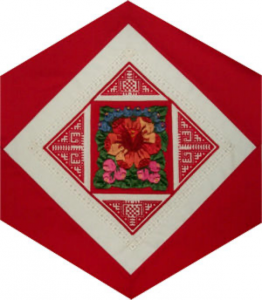Croatia

The Block
A one hundred-year-old family heirloom, taken from an embroidered blouse belonging to Jelena Vrdoljak, is appliquéd in the centre of this block. The lovely floral design is created in silk embroidery using both satin and bullions stitches. Needle-weaving surrounding the centrepiece forms a traditional diagonal pattern, incorporating Croatia’s national checkerboard symbol. The weaving is done in the popular red colour ––signifying innocence and contentment with life. The border consists of white-on-white pulled-thread work, a technique in which threads from the fabric are pulled very tightly and tied to form patterns of holes in the fabric.
Cultural Profile
Croatia is a small European country along the eastern coast of the Adriatic Sea. Known as Hrvatska to Croatians, it is a relatively small nation with a large number of historical monuments that reflect different cultures. Sitting at the meeting point of Central Europe and the Balkans, Croatia has seen Slavic, Venetian, Austrian, and Ottoman influences. The diversity of its people is evident in many areas, including paintings, music, architecture and sculpture. Croatian is the country’s official language, spoken by the majority, although most of the population also speaks at least one foreign language such as German, French or Italian.
Croatians have a strong sense of kinship and depict their lives and emotions through folklore. Each occasion has its own song or dance, including the kolo, which is accompanied by players of the tambura (Croatian mandolin). Croatians also have a spectacular variety of traditional costumes that creatively coordinate fabrics, shapes and colours with an abundance of lace. Gold and multi-coloured threads depict the prosperity of various regions. These costumes are elaborately embroidered with varying designs and colours that identify the region of the wearer.
Silkworms were introduced in Croatia during the 16th century and continued to be bred in the Konavle Valley until the war during the 1990s, when many lost their homes and livelihoods. However, the silk industry has been revived and is still running today. Weaving is still practiced in Croatia and often complex embroidery designs have been adapted and woven in the cloth. Croatian lacemaking is also world renowned, with three towns all claiming special techniques: needlelace is done in Pag, bobbin lace in Lepoglava and aloe lace, where the thread is collected from local aloe plants, is done on the island of Hvar by Benedictine nuns in the local convent.
Croatians are known for their traditional singing styles including the Ojkanje, where the singers use a throat-shaking technique, the two-part singing in the Istrian scale where the singers often improvise, the powerful Klapa, a form of a capella singing and the humourous and daring Bećarac, where singers must use their quick wits to improvise songs about subjects that might otherwise be considered inappropriate if expressed in regular speech. Traditional musical instruments of Croatia include the mih, a type of bagpipe, the sopila, similar to an oboe and always played in pairs, and the tamburica, a type of long-neck lut.
Croatians have been coming to Canada since the 1880s, although a legend persists that they were aboard the third expedition of Cartier and Roberval in 1541-42. They have played an important role in many aspects of Canada’s development. Early migrant workers helped build the transcontinental railroad and develop the mining, forestry, agriculture and fishing industries. During the interwar years, many were hard-working factory hands in Canada’s growing industrial sector. Croatians have also been active in the visual and performing arts, and a number of Croatian Folklore Festivals are now held annually in cities across the country. Many Croatians, most notably hockey’s Mahovlich brothers, have also enhanced professional sports in Canada.
There are numerous Croatian communities across Canada and the 2011 census indicates that there are almost 114,000 Canadians of Croatian descent now living here.
Sponsor: Lanark County Quilters Guild
